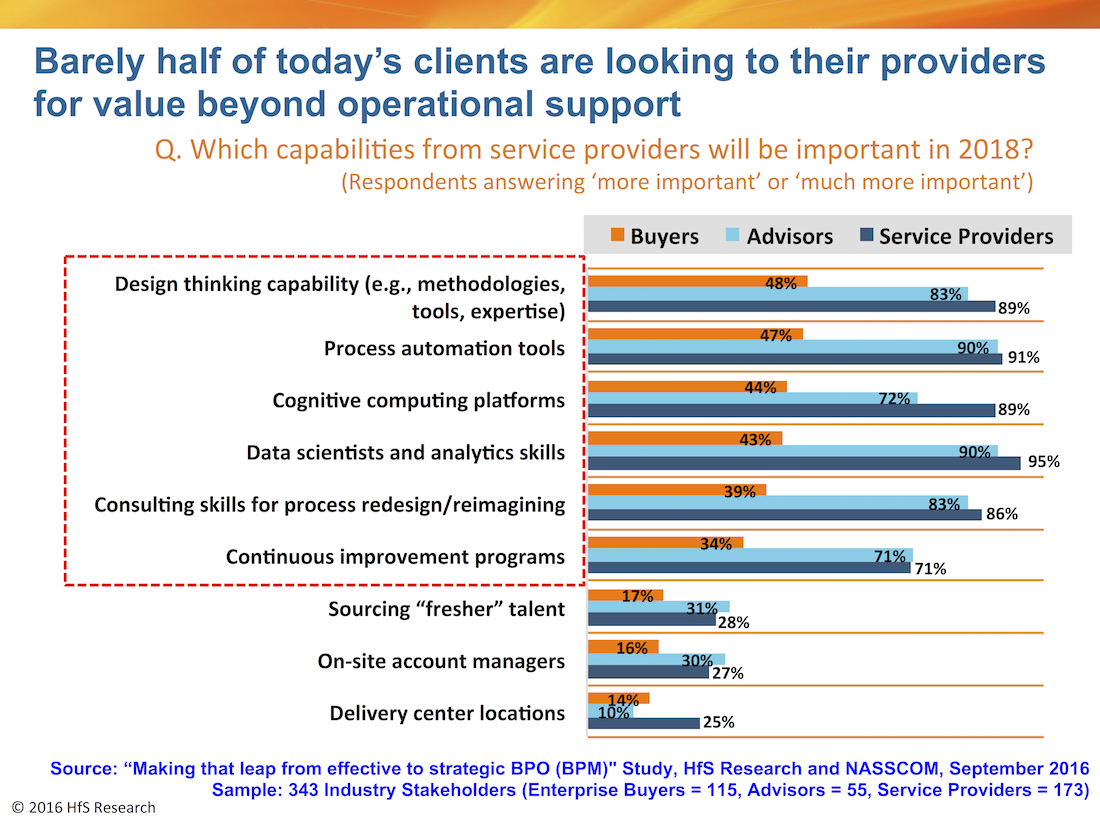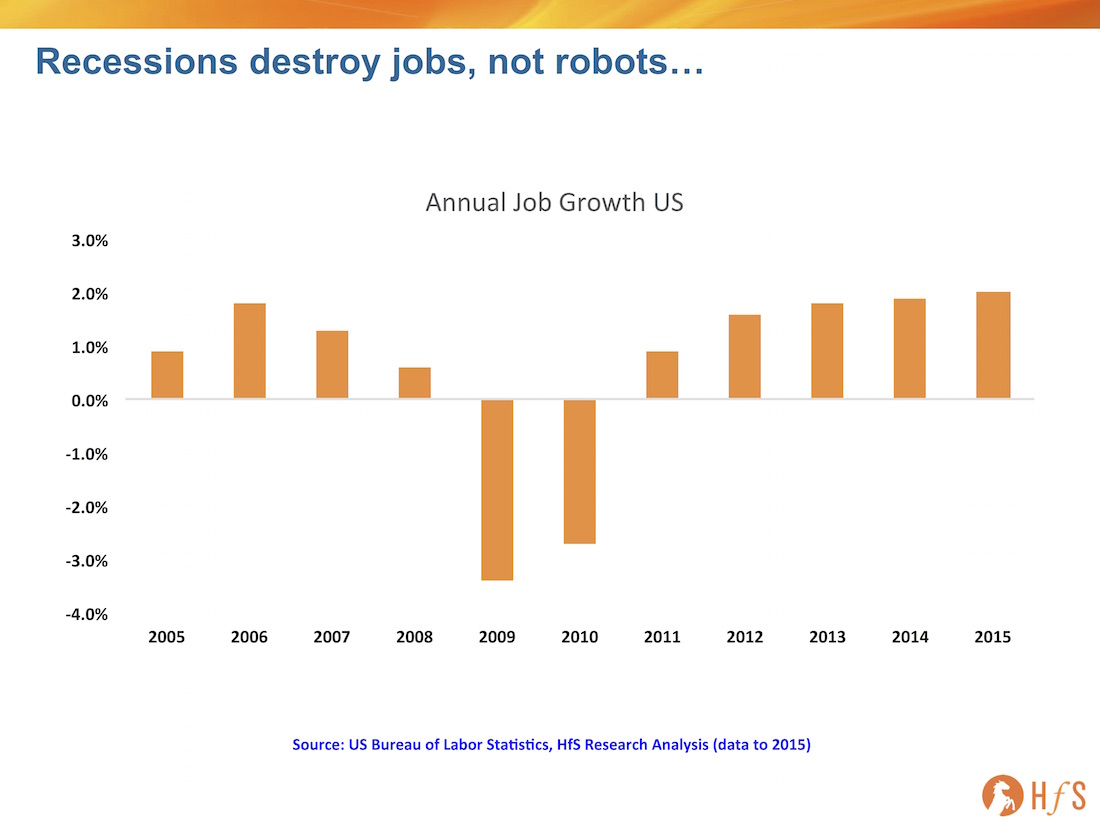
What a September that was the industry formerly known as “outsourcing”!
An “industry” still searching endlessly for an identity, a purpose and a value proposition, founded on more than dredging up cost savings through lower wages, tortuous conferences for bored sourcing advisors and pompous analysts who ask idiotic “questions” which end up confusing themselves… but finally we finding some salvation for our industry! Finally outsourcing doesn’t have to fester on the scrap heap of legacy commoditized business models, akin to what happened to the telecom industry…
The State of Denial is over in the States. In White Plains for the HfS Cognition Buyers’ Summit, the mood was the most upbeat I have experienced in a long time – clients were peeping above the bed covers and saying “I want real examples, I want to touch and feel this automation stuff… tell me what I need to know and how this is done”. There as a stark admission that “our kids will be alright, they live and breathe what is needed in organizations today, its us mid-career folks who need to be worried – we’re the ones who need to reinvest ourselves if we are to stay relevant”.
Many of the Indian providers want to extend their stay in Denial a while longer. Then we took the HfS team over to Bangalore, India for NASSCOM’s 19th BPM (BPO) Strategy Summit, where most of the local service provider dignitaries were firmly hiding under their bed covers asking the same old question: “How can we sell higher value deals to the same clunky big enterprises without doing anything differently since we started doing this stuff 19 years ago?”. Clearly most of these guys won’t change course while they’re still enjoying a (diminishing) 5% revenue growth and still making (diminishing) healthy profit margins…
The Problem dogging the outsourcing industry: Too many buyers simply aren’t looking to their providers with the expectation they can receive more than the basics
Perhaps most telling is this data point from our brand new industry study of 343 industry stakeholders, conducted with NASSCOM for the summit, where it’s clear over half of today’s buyers do not view their providers as purveyors of the new high value capabilities that will help them break out of their legacy tail-spin. This is in stark contrast to the views of the service providers themselves and sourcing advisors, where the vast majority clearly view the role of the service provider as pivotal to help clients advance their capabilities in areas such as Design Thinking methodology, automation, cognitive computing, analytics and process redesign:

Click here to enlarge
The Solution to making outsourcing great again: Supporting and enabling disruptive business models
The big issue today, in my view, is that the outsourcing industry is too focused on the wrong things, such as staving off the “threat” of automation and protecting traditional headcount-based delivery. So let’s break down the issues to come up with some ideas for preparing for the future:
Automation is not the threat to outsourcing, it’s Digital Disruption. The real threat comes in the form of disruptive competitors using digital platforms and cognitive computing, that can wipe out your enterprise overnight. Imagine a new bank appearing, with a great mobile app, immediate customer service via chat / phone etc. Or a rival insurance firm that delivered everything you needed at half the premiums, but twice the usability? You’d switch in a heartbeat wouldn’t you? And these capabilities are here today, they’re not coming tomorrow. Today’s clients are under incredible pressure to be more nimble, more intelligent, more scalable and more digital than ever. And this is right across industries, where the threat and opportunity posed by digital disruption is rife. Remember, it’s recessions that destroy jobs, not robots:

Click here to enlarge
Outsourcing is the perfect solution to help scale and operate disruptive business models
BPO and IT services provide the modern business with the ability, not only to survive and thrive in today’s disruptive market, but it’s here for today – not just tomorrow. BPO is not some legacy service that’s going the way of the robot, it’s a very real solution that is more imperative than ever for the survival of our most advanced digitally-savvy businesses.
I recall one of our analysts recently coming back from a visit to AirBnb’s new BPO contact center and she was actually shocked – “Phil, it’s just your classic BPO center providing traditional customer support services.” Digital businesses actually need BPO to function – why do they want to going out and hire armies of support staff and processing people when they need to attack their markets at warp speed?
Digital disruption is driving an unprecedented level of urgency and paranoia among enterprise leaders – and outsourcing can really help
In many industries today, digital business models can completely take established legacy enterprises out overnight. If you are an insurance firm with 10,000+ people processing claims onshore using green screen computers, or a bank which still has hundreds of branches employing tellers from the 1970s, or a retail outlet with no mobile app strategy, you are at dire risk of competition coming at you with a completely mobile app-driven, user friendly, intuitive and cognitive business model, supported by intelligent, affordable BPO and IT operations. So you need partners who can help you pivot fast, and combat these potential fatal threats to your business model… and where better to look than BPO and IT services firms which can provide the scale, talent and analytics you need to operate with the flexibility you need, without the burdensome capital investments?
Outsourcing can make itself great if it can pivot between helping today’s traditional enterprises and tomorrow’s emerging digital businesses
When we look out into the future of the world leading companies, the Global 2000 in five years time will look very different to what it does today. As we’ve discussed many times before, enterprises are looking to focus on their core and stop adding size and scale to grow. With businesses which interact with their customers, partners, suppliers and employers using apps and collaborative tools, the focus is quickly shifting to growing profitability through smart scalability of customer base, as opposed to linear revenue growth. This means a $100m digital business in the future could command $10-20m in outsourcing spend a year to drive its business forward. But the crux of the problem today us today’s outsourcing providers are still obsessing around pursuing $5bn+companies because they only see their success in going through the initial labor arbitrage, as opposed to pursuing clients which to not have the legacy back office burden and just need agile services they can plug into quickly and effectively.
The emerging outsourcing customer needs a very different approach to account management, sales and service delivery
Outsourcing providers need to completely revamp their account management models to cater for the evolving digital business – but this something well within their capabilities… just go hire forward-thinking sales leaders and build teams of people who can work with the emerging companies of the future, not just the ones of the past. In addition, providers need to ensure they have the ability to cobble together smaller delivery teams which can quickly grasp the needs of these evolving clients. Hence, they need large investments in training and Design Thinking to help with outcome and goal setting with clients. The old “master/slave” delivery model will be a thing of the past with the emerging digital business, which will demand much faster ramp-up times and staff who can quickly respond to their unique business needs.
The Bottom Line: It’s time to embrace our Scary Bright Future – we have the tools to make it happen!
So it’s time to be smart, time to be prepared to help our clients combat, and ultimately win this war with digital disruption. BPO and IT services provide a critical foundation, so let’s prepare to reinforce to the world what we stand for and the sustained value we deliver every day to thousands of clients around the world.
Posted in : Business Process Outsourcing (BPO), Digital Transformation, The As-a-Service Economy






Excellent post Phil.
Completely agree the outsoucing business needs to focus on the emerging digital businesses – only focusing on legacy enterprise headcount deals is dying on the vine for many of these firms,
Steve
Phil,
One of your best yet – spot on with the onus needing to be on addressing digital disruption. Automation is noise, while digital disruption theatens many companies very exitence,
Rahul
Love this piece, Phil! You’re comments on the Indian service providers are spont on – they won’t do anything until they start to feel the pinch financially.
Phil,
Excellent piece. My question to you is how traditonal BPOs such as Conduant (Xerox) and HP can survive in this climate. I can see how the Indian suppliers can cotinue to compete on cost, but these traditional BPOs are surely in trouble?
Theresa
Great piece, Phil. I am starting to work with some forward thinking Service Providers and Advisors, who "get" Cognitive Computing and don’t expect to deploy it themselves. They want to work side by side to deliver the best solution for the client. Thanks for reinforcing this behaviour!
Like the optimism Phil, but do you really think the current bactch of service providers can really break out of the FTE model?
Phil,
Love the rallying cry! Completely agree it’s time to rethink how to price, staff, manage and deliver BPO. If we fail to shape up to more nimble, less headcount-heavy businesses, we’ll go into decline – and probably faster than we realize,
Guy
As always Phil Fersht spot on article … Thanks! No doubt who (BPO, ITO provider) gets it first will be an undispute leader of tomorrow and no doubt that Forward-Thinking Account Management or Solution & Sales leaders, Adaptable Delivery Leaders with Creative Thinking capability very much Client goals & needs and Outcome focused is a must to make it happen!
Phil, excellent article!
Perhaps the truth is that both buyers and service providers are feeling thoroughly exhausted by all the buzz words being bandied around without much clarity that they have simply decided to batten the hatches and wait it out? I mean, there is only so much of sizzle around “Digital Disruption”, “Robotic Process Automation”. “AI and Cognitive”. “Machine Learning”. “Deep Learning”, “Cognitive Robotics”…..etc that anyone can put up with without ultimately having to see, touch, feel and eat the sausage? Perhaps resolving the confusion in the jargon is an ideal first step?
Sri Annaswamy
Phil,
Really excellent insights – as always. Especially agree with the comment about the Indian providers – they won’t change anything unless their cash flows really start to get hit, and then they won’t know what to do beyond finding cheaper cities and cheaper freshers,
Ramesh
“Recessions destroy jobs, not robots”
Well said!
Hi Phil,
Excellent insights! We act on this field and fully agree with the article.
Rgds
Tibor
@Theresa – yes, the "traditional" BPOs need a plan to offer services to clients that are further up the value chain (i.e. analytics, process consulting) and aligning operations with digital, automation and cognitive capabilities. The key is to invest in more strategy and consulting skills in these areas, sell to the retained orgs and they’ll win the outsourcing biz every time…
PF
@Sri – I don’t think the jargon gets “resolved” – I think it gets increasingly ignored as clients just get better at explaining what they actually *need*, as opposed to suppliers creating flashy sounding things that they think they can sell to clients who only half understand it… in fact, I have challenged suppliers repeatedly to explain what they mean by “digital transformation” and several of them just cannot answer it! We actually live in an age where we talk unintelligable bullsh*t with each other =)
PF
@Andy – will some providers ever break out of FTE? Many will be forced to as more work is automated and the use of “people” is more for exceptions and escalations. For example, how do you price for using “semi-automated virtual agents” which essentially form that first later of customer service. How many live agents do you need to manage the virtual ones? Or how many F&A staff do you need to supervise automated e-invoicing processes?
Yes, there will always be an FTE element, but the typeof work will become less effort driven over time and more “supervisory”. So the “cost per roboboss” maybe where this goes =)
PF